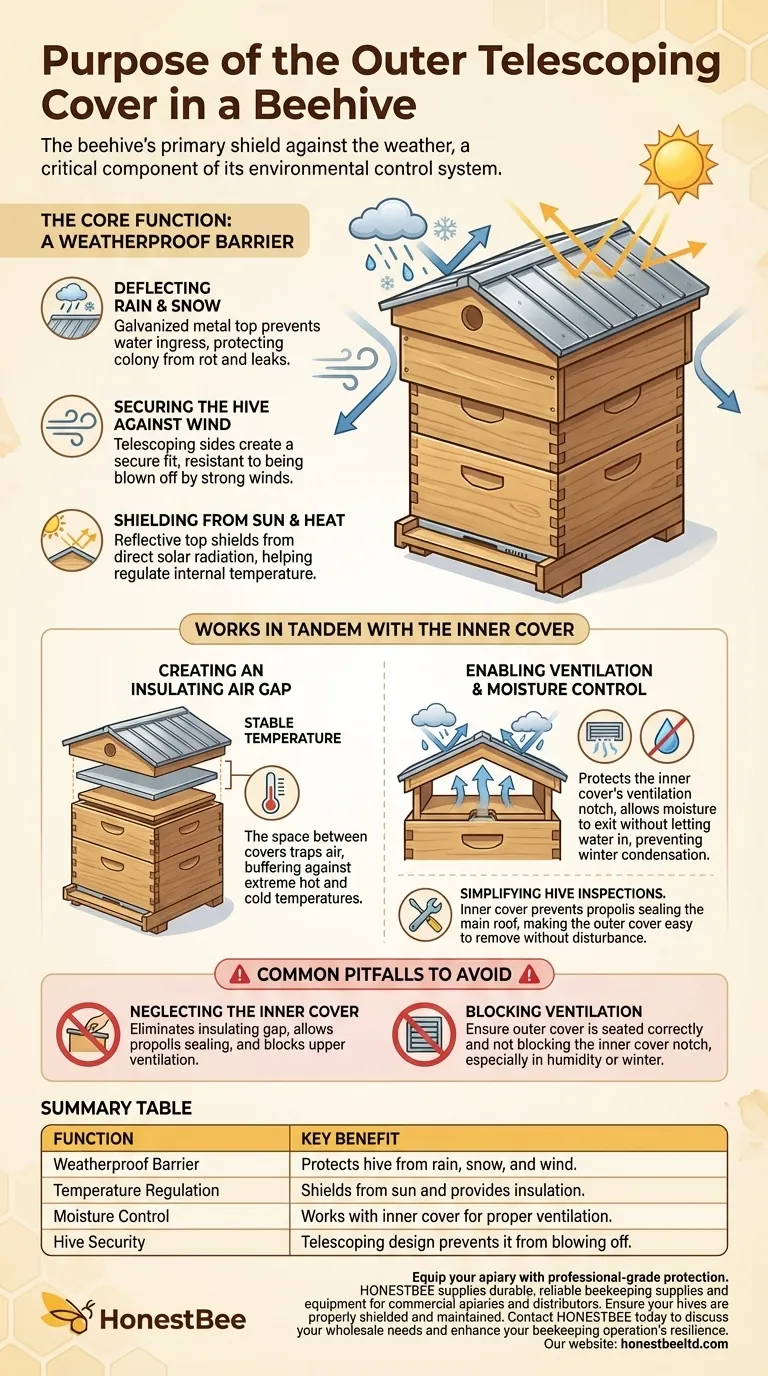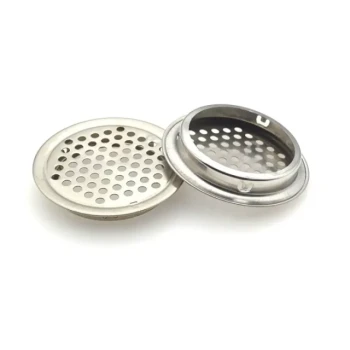In short, the outer telescoping cover is the beehive's primary shield against the weather. It is a wood-and-metal roof designed to fit securely over the top of the hive, extending down the sides to protect the colony from rain, snow, sun, and wind.
A common mistake is to view the outer cover as just a simple lid. In reality, it is a critical component of the hive's environmental control system, working in tandem with the inner cover to regulate temperature, moisture, and security.

The Core Function: A Weatherproof Barrier
The most fundamental job of the telescoping cover is to create a durable, weatherproof seal at the top of the hive. It accomplishes this through a few key design features.
Deflecting Rain and Snow
The top of the cover is sheathed in a layer of galvanized metal. This feature prevents water from seeping through the wood, which would lead to rot and leaks that could devastate a colony.
Securing the Hive Against Wind
The term "telescoping" refers to the cover's sides, which extend several inches down over the top hive body. This design creates a secure fit that is highly resistant to being blown off by strong winds, unlike a simple flat lid.
Shielding from Sun and Heat
By providing a solid, reflective top, the outer cover shields the hive from direct solar radiation. This helps the colony maintain a stable internal temperature without expending excessive energy during hot summer days.
How It Works with the Inner Cover
The telescoping cover rarely works alone. It is designed to function as the outer layer of a two-part roofing system, sitting directly on top of the inner cover.
Creating an Insulating Air Gap
The space between the inner cover and the outer telescoping cover creates a pocket of trapped air. This air gap acts as a crucial layer of insulation, helping to buffer the colony from extreme external temperatures, both hot and cold.
Enabling Ventilation and Moisture Control
The inner cover typically has a small notch or hole that provides an upper entrance for the bees. This also serves as a critical vent for moist air to escape the hive. The outer cover protects this vent from rain, allowing moisture to exit without letting water get in, which is vital for preventing condensation in the winter.
Simplifying Hive Inspections
The inner cover prevents the bees from sealing the main roof to the hive body with propolis (a resinous bee glue). Because the bees seal the inner cover instead, you can easily remove the outer cover without disturbing the colony and then gently pry off the much lighter inner cover.
Common Pitfalls to Avoid
While the telescoping cover is the industry standard for good reason, its effectiveness depends on proper use within the hive system.
Neglecting the Inner Cover
Using a telescoping cover without an inner cover is a common mistake. Doing so eliminates the insulating air gap, allows the bees to glue the roof shut, and removes the option for critical upper ventilation.
Blocking Ventilation
The system is designed to breathe. When closing up a hive, ensure the outer cover is seated correctly and not accidentally blocking the ventilation notch on the inner cover, especially during periods of high humidity or winter.
Making the Right Choice for Your Hive
Understanding the role of the telescoping cover helps you maintain a healthier, more resilient colony.
- If your primary focus is maximum weather protection: The telescoping cover is the standard and most reliable choice for nearly all climates.
- If you are preparing for winter: Ensure your inner cover is positioned to allow for upper ventilation, which the telescoping cover will then protect from the elements.
- If you want easier hive inspections: The two-part system is essential for preventing a difficult-to-break propolis seal on the main hive roof.
Ultimately, mastering your equipment is the first step toward becoming an effective beekeeper.
Summary Table:
| Function | Key Benefit |
|---|---|
| Weatherproof Barrier | Protects hive from rain, snow, and wind. |
| Temperature Regulation | Shields from sun and provides insulation. |
| Moisture Control | Works with inner cover for proper ventilation. |
| Hive Security | Telescoping design prevents it from blowing off. |
Equip your apiary with professional-grade protection. The right equipment is fundamental to a thriving colony. HONESTBEE supplies durable, reliable beekeeping supplies and equipment—including telescoping covers and inner covers—to commercial apiaries and distributors through our wholesale-focused operations. Ensure your hives are properly shielded and maintained. Contact HONESTBEE today to discuss your wholesale needs and enhance your beekeeping operation's resilience.
Visual Guide

Related Products
- Professional Insulated Winter Hive Wrap for Beekeeping
- Long Langstroth Style Horizontal Top Bar Hive for Wholesale
- Professional Drop-Style Hive Handles for Beekeeping
- Wholesales Dadant Size Wooden Bee Hives for Beekeeping
- HONESTBEE Professional Long Handled Hive Tool with Precision Cutting Blade
People Also Ask
- How does insulation help bee hives in severely cold weather? Conserve Energy & Ensure Colony Survival
- Why is insulation important for hives during winter? Ensure Your Bees Survive and Thrive
- What are the durability features of Bee Blankets? Built to Last in Demanding Apiary Conditions
- What is the advantage of an insulated outer cover? Boost Winter Survival & Spring Buildup
- What factors ensure bees stay warm and healthy during winter? Master the 3 Keys to Hive Survival



















